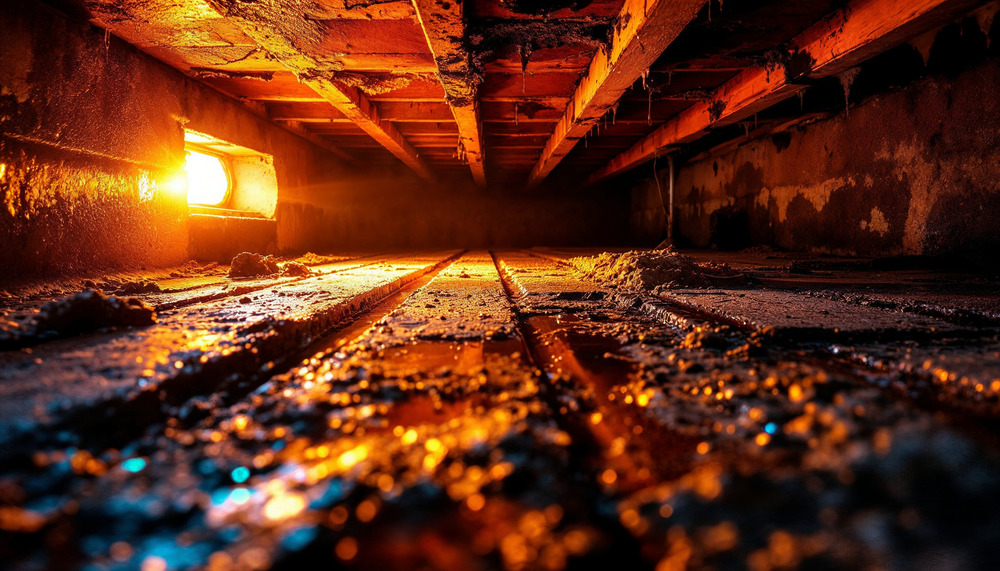Why Crawl Spaces Are a Hotspot for Mold Growth in Long Branch Homes?
Crawl spaces naturally harbor moisture due to their proximity to the ground. In areas like Long Branch, where coastal humidity and fluctuating temperatures are common, this dampness can quickly lead to mold colonies. When combined with poor ventilation and organic materials like wood or insulation, these enclosed spaces become the perfect breeding ground for mold.
Warning Signs That Mold Might Be Spreading from Your Crawl Space
If your home has a crawl space, there are certain red flags you should watch for:
- Musty odors seeping into living areas
- Increased allergy or respiratory symptoms among residents
- Visible mold around baseboards or lower walls
- Warped floors or soft wood structures above the crawl space
These are all signs that mold may be taking hold beneath your home and making its way inside.
How Mold Travels from Crawl Spaces Into Indoor Air?
Many homeowners don’t realize that air from your crawl space rises into your living areas through a process called the “stack effect.” Warm air rises and pulls lower air upward—bringing with it spores, allergens, and odors from your crawl space. Over time, this can reduce indoor air quality, trigger health issues, and increase cleaning and maintenance costs.
Tips for Preventing Mold Growth in Your Crawl Space
Luckily, there are effective strategies you can implement to reduce moisture and mold risks in your crawl space:
- Install a vapor barrier over exposed soil to block ground moisture
- Seal vents and gaps to reduce humid air entry
- Use a dehumidifier to maintain optimal moisture levels
- Insulate crawl space walls and avoid fiberglass, which holds moisture
- Conduct regular inspections for signs of leaks or fungal growth
These actions help make your crawl space less hospitable to mold, preserving your home’s integrity.
When Should You Consider Professional Crawl Space Mold Remediation?
If you’re noticing signs of widespread mold or health symptoms, it’s time to call in professionals. Crawl space mold can penetrate wood, insulation, and even subflooring—making DIY cleaning ineffective or unsafe. Professional remediation includes:
- Thorough inspection and moisture mapping
- Safe removal of contaminated materials
- Application of antifungal treatments
- Long-term sealing and waterproofing solutions
Hiring experts ensures the job is done right and prevents future outbreaks.
How Advanced Disaster Recovery Inc. Can Help Long Branch Homeowners?
At Advanced Disaster Recovery Inc., we specialize in identifying, removing, and preventing mold in crawl spaces across Long Branch, Monmouth County. We understand the local climate challenges and use industry-leading tools to restore safety and cleanliness to your home. Whether you need a full crawl space encapsulation or emergency mold remediation, our experienced team is here to help.
And if you’re too busy to tackle this problem on your own—or simply want the peace of mind that comes from a job well done—we’ve got your back. From inspection to post-remediation monitoring, we handle everything so you can breathe easy.
Don’t Wait—Protect Your Indoor Air Quality Today
Mold isn’t just an eyesore—it’s a serious health and structural risk. If your crawl space hasn’t been inspected recently, now is the time to act. Even small amounts of moisture can lead to costly damage if ignored. Whether you’re dealing with an active infestation or want to prevent one, Advanced Disaster Recovery Inc. is your local partner in protection.
Contact us today to schedule a professional crawl space evaluation and mold assessment in Long Branch, Monmouth County. Don’t let hidden mold take over your home—let us stop it at the source.

